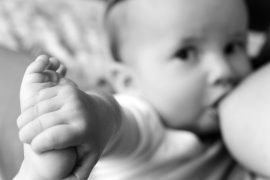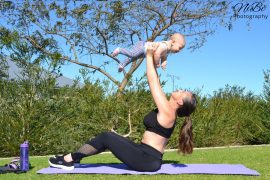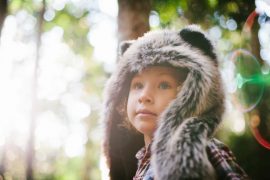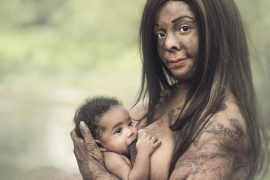Social glue
But there are even wider implications. Oxytocin plays a vital role in all affectional bonds and the formation of the social emotions that are vital not only in the individual life but that are also crucial to society. The right hemisphere of the brain, which is dominant for the first three years of life, is involved in the development of an ability to ‘read’ others and a capacity for empathy. The right hemisphere is linked to the limbic area -sometimes called the emotional brain. Neuroscience research has revealed that positive mother-child interactions are crucial for the development of social emotions that make us the caring, responsible citizens that every society needs. Not for nothing has oxytocin been dubbed the ‘glue of society’.
Mothers descriptions of their long-term breastfed children show them to be not only securely-attached but also reveal well developed social emotions. They are described by their mothers (and fathers) as kind, generous, sensitive, compassionate, empathic. There is a marked ability, even in very young toddlers, to ‘read’ and interpret need and unhappiness in other children and respond empathically.
He is very empathic towards other babies and children who are crying… he’ll say, ‘The baby’s crying, he needs a hug and some milk’. When he was 18 mths old there was a baby crying on the plane and he said, ‘Baby crying, baby need milk’.England. Ch 1: bfdg 2yrs.
Emotionally I feel it has been of great benefit to E as a form of contact and reassurance. She now seems very confident and ready to take on her daily life at school, but also very empathic and aware of the feelings of others and the need for closeness and cuddles. Jersey, CI. Ch1: bfdg 4yrs.
Statement from a child in England breastfed for 7.3yrs:
I felt happy and cosy and sleepy when I was having lolo. If I see a baby having lolo it makes me happy because I remember me having lolo. If I see a baby having a bottle, it makes me worry a bit, I feel a bit sad, I don’t know why.
Anthropologist Katherine Dettwyler3 investigated a large body of primate research to see what might be a natural term of breastfeeding for humans were we to be free of cultural constraints. Using a range of indicators, she came up with a natural breastfeeding term for humans of 2.5yrs to 7yrs.
Judging from my experience with my own daughter (self-weaned at the age of six and a half), an experience massively corroborated by my survey results, breastfeeding is not only innate behaviour in newborns, it is innate behaviour throughout the duration of breastfeeding.
With good reason therefore to believe that children have an evolved biological-emotional-neurological need to breastfeed for several years, and with almost four unbreastfed generations and social problems wherever we look, a question (in need of urgent answer) is begged: what are the psycho-emotional and social consequences of thwarting a child’s need for ongoing breastfeeding?
References
- Attachment Theory:
I Bretherton, The Origins of Attachment Theory: John Bowlby and Mary
Ainsworth, Developmental Psychology 1992, 28: 759-75
- Neuroscience:
T Esch et al, Medical Science Monitor, 2002; Neuroendocrinology Letters,2003.
T Esch and G B Stefano ‘The Neurobiology of Love’, Neuroendocrinology Letters No3, Jun Vol 26, 2005
M Kosfeld, M Heinrichs, P J. Zak, U Fischbacher, E Fehr, Oxytocin increases trust in humans, Nature, 435, 673-676 (2 June 2005)
D D Francis et al, ‘Variations in maternal behaviour associated with difference in oxytocin levels in the rat’, Journal of Neuroendocrinilogy.
S Carter, ‘Developmental consequences of oxytocin’, Physiology & Behaviour, 2003, 79: 383-97
Bernal and Richards (1970). Cited in N M Else-Quest et al, ‘Breastfeeding, bonding, and the mother-infant relationship’, Merrill-Palmer Quarterly, Oct 2003, Vol 49
R Carroll, An Interview with Allan Schore – the American Bowlby. http://www.thinkbody.co.uk/papers/interview-with-allan-s.htm
M Lavelli and M Poli, ‘Early mother-infant interaction during breast and bottle feeding’, Infant Behaviour and Development, 1998, 21(4): 667-83
Ryff and Singer 2001. Cited by S Carter in How Do I Love Thee? A Biological Perspective, presentation for the Foundation for the Advancement of Behavioural and Brain Sciences, 8 Feb 2007
S Carter, ‘Developmental consequences of oxytocin’, Physiology & Behaviour, 2003, 79: 383-97
A N Schore, The Effects of Early Relational Trauma on Right Brain Development, Affect Regulation, & Infant Mental Health.
- K. Dettwyler, ‘A Time to Wean’, in Breastfeeding: Biocultural Perspectives,
eds Stuart-Macadam and Dettwyler
* 2040 responses from 48 countries.
© Ann Sinnott
Breastfeeding Older Children, Free Association Books, Dec 2009/Jan 2010
Ann Sinnott’s presentation from the GOLD Lactation Conference May 2010 is now CERPS-validated for IBCLC training and is available for download
http://www.health-e-learning.com/courses/experts-in-lactation/155-xl22











Thanks you for such a beautiful and important article! i dont feel so alone anymore! my todler 2.3 years old and still bresatfed! <3
Thank yoy